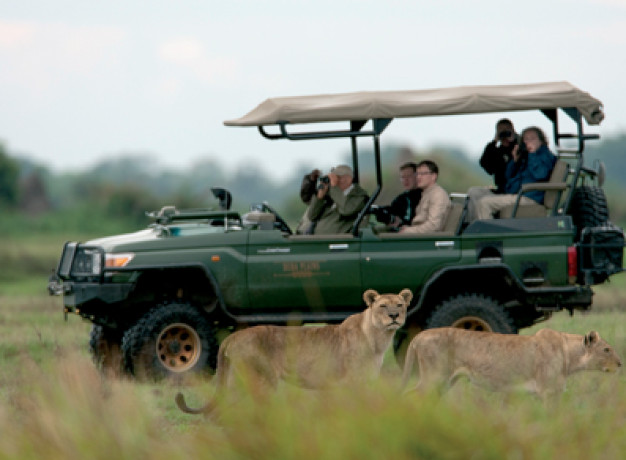Inclusions:
-
Lodges/Camps/House boat
-
13 Breakfasts, 13 Lunches & 13 Dinners
-
4X4 Safari Vehicle-Game Drives
-
Cessna Grand Caravan aircraft
-
English Speaking Guide
-
Locally Escorted
-
Game Drives
-
Game Walks
-
River Cruise
-
Overnight Cruise
-
Mokoro ride
-
Entrance Fees Included
-
Most Tipping
Inclusions:
-
Lodges/Camps/House boat
-
13 Breakfasts, 13 Lunches & 13 Dinners
-
4X4 Safari Vehicle-Game Drives
-
Cessna Grand Caravan aircraft
-
English Speaking Guide
-
Locally Escorted
-
Game Drives
-
Game Walks
-
River Cruise
-
Overnight Cruise
-
Mokoro ride
-
Entrance Fees Included
-
Most Tipping
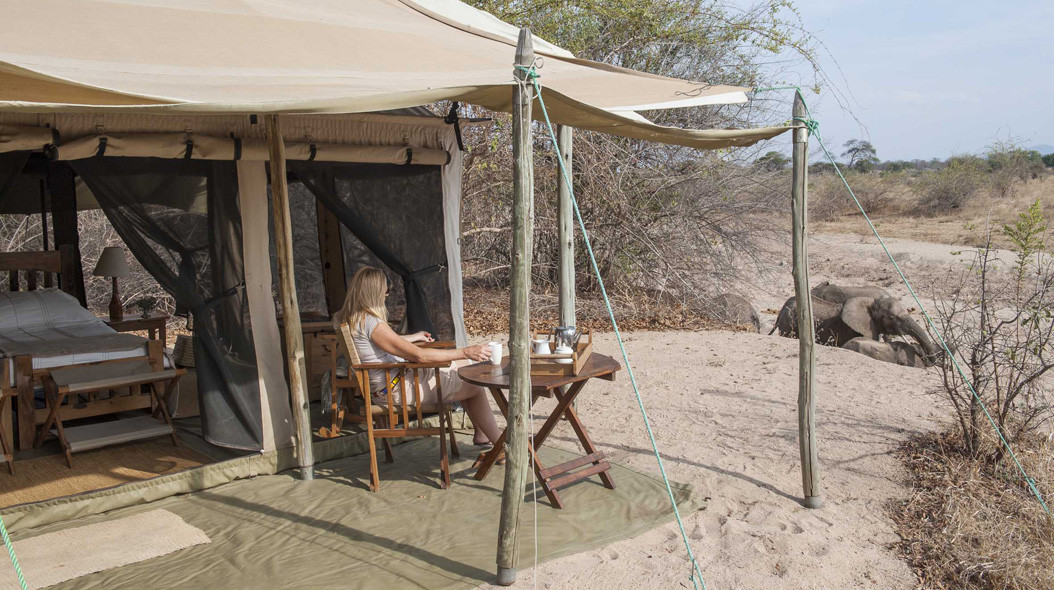
Trip Summary
Group Size: Maximum of 8 passengers
Departs: Scheduled departures during the year
..................................................
Experience adventure, exhilaration and fascination on board our Scenic Air Safari’s luxurious Cessna Grand Caravan aircraft as you fly over Africa’s most unique, beautiful and in places untouched landscapes. Our exclusive journey through the heart of Africa opens up a world of discovery. Explore the alluring magnificence of Botswana, Zambia, Malawi, and Tanzania on an amazing authentic African safari in style. Visit extraordinary locations in some of the very best wildlife reserves Africa has to offer. Embrace local cultures and insights whilst staying in elegant lodges, hotels and safari camps. Whether exploring on game drives, appreciating the unique landscapes, enjoying activities at the stylish lodges, camps or houseboat, or just relax in comfort as Africa unfolds its secrets before you. This unique journey will create unforgettable memories to last a lifetime.
Full Itinerary
Day 1 - Livingstone / Victoria Falls - Okavango Delta
Flight time: Kasane to Duba Plains – approximately 1 hour, 20 minutes
This morning you will be met and transferred to Kasane in Botswana where you will board your flight into the Okavango Delta One of the most sought after wilderness destinations in the world, the Okavango Delta gives entrance to the spectacle of wild Africa such as dreams are made of – the heart-stopping excitement of big game viewing, the supreme tranquility and serenity of an untouched delta, and evocative scenes of extraordinary natural beauty. (LD)
Located on a private 77,000-acre concession deep in the extreme northern reaches of the Okavango Delta, lies Duba Plains Camp. The word “remote” could not be more relevant than here, a place only accessible by plane for most of the year thanks to the seasonal floods. The 6 beautifully appointed tents overlook vast floodplains and create an authentic atmosphere of discovery. Wild animals often wander through camp – a truly magical experience to be celebrated rather than feared. Renowned for their pursuits of the huge buffalo herds which roam these plains, Duba Plains’ indomitable lions have become legends, hunting primarily in broad daylight and at home in both water and land.
Day 2 - Okavango Delta
Enjoy the scheduled morning and afternoon game viewing activities offered by the camp. Morning and afternoon game drives are offered in specially adapted open safari vehicles, as well as mokoro excursions (the definitive Okavango Delta experience) and power boat cruises which explore the Delta’s channels, lagoons and floodplains. (BLD)
Day 3 - Chobe River
Flight time: Kasane to Duba Plains – approximately 1 hour, 20 minutes
This morning you will fly back to Kasane from where you transfer to your houseboat on the Chobe River. At the confluence of the Chobe and Zambezi Rivers lies Impalila Island, which is also the meeting place of four African countries: Namibia, Botswana, Zambia and Zimbabwe. This phenomenon is the only one of its kind in the world and it is within this unique geographic area that the Chobe Princess operates. (BLD)
The Chobe Princess provides the ultimate luxury cruising safari on the Chobe River. Small and intimate, this houseboat provides guests with the opportunity to stay overnight within the Chobe National Park at prime docking sites along the river. There is something incredibly relaxing about cursing on the Chobe River, along the banks of the Chobe National Park, watching the outstanding wildlife and birdlife from the houseboat. The accommodation deck is comprised of 5 spacious bedrooms with en-suite facilities and sliding windows opening onto the water, spanned by transparent mosquito screens.
Day 4 - Chobe River
Game viewing by boat into the Chobe National Park is a remarkable experience – where huge herds of elephants come down to drink together with an extensive array of other game such as buffalo, giraffe, leopard, lion, kudu, waterbuck, puku, lechwe, impala, baboons and the endemic Chobe bush buck. The evening boat trip provides guests with the unforgettable experience of witnessing a true African sunset, while being surrounded by herds of elephant and sipping on a cold sundowner. Other activities include fly-fishing, bird watching, mokoro excursions, and bush walks on Impalila Island. (BLD)
Day 5 - South Luangwa National Park
Flight time: Kasane to Lusaka airport – approximately 1 Hour 52 Mins
Flight time: Lusaka to Lukuzi Airstrip (South Luangwa) – approximately 1 Hour 30 Mins
This morning you return to Kasane and fly north through Lusaka and on into the South Luangwa National Park in eastern Zambia. Experts have dubbed South Luangwa to be one of the greatest wildlife sanctuaries in the world, and not without reason. The concentration of animals around the Luangwa River, and its oxbow lagoons, is among the most intense in Africa. (BLD)
Tafika Camp offers exceptional game viewing combined with a selection of exciting activities including game drives, walks, visits to Mkasanga village and – for the more energetic – daily mountain bike rides. With 6 comfortable and spacious en-suite chalets, each with its own romantic outdoor shower, the camp offers a truly intimate experience. Situated just outside the Nsefu Sector of the South Park it boasts some if the finest Leopard viewing in Zambia. The Leopard sighting opportunities combined with the unusual and exhilarating safari activities, and the camps friendly atmosphere, make Tafika Camp the perfect place to base your South Luangwa wildlife experience.
Day 6 - South Luangwa National Park
Enjoy the game viewing activities offered by the camp. The Luangwa River is the most intact major river system in Africa and is the life-blood of this 9059 square km park. The park hosts a wide variety of wildlife, birds and vegetation. The now famous ‘walking safari’ originated in the South Luangwa and is still one of the finest ways to experience Africa’s pristine wilderness first-hand. The changing seasons add to the area’s richness, ranging from; dry, bare bushveld in the winter, to a lush, green wonderland in the summer months. There are 60 different animal species and over 400 different bird species in South Luangwa National Park. (BLD)
Day 7 - Lake Malawi
Flight time: Lakuzi Airstrip to Mfuwe – approximately 18 Mins
Flight time: Mfuwe to Mzuzu – approximately 1 Hour 5 Mins
Flight time: Mzuzu to Likoma Island – approximately 23 Mins
Today you fly south to Likoma Island, set in the crystal clear waters of Lake Malawi. Likoma Island is found towards the north eastern part of the lake, within the territorial waters of Mozambique but part of Malawi and linked to the rest of the country by a steamer service. The island is quite hilly in places, mostly dry and sandy, and baobabs are a common feature of the landscape although big trees are generally scarce. The population is over 5,000 people, scattered in little villages throughout the island. (BLD)
Kaya Mawa is set on a rocky promontory on the southern tip of Likoma Island. The name means “maybe tomorrow” and is the perfect phrase for this wonderful retreat. The contemporary lounge and dining area is the perfect location for beach dinners or a relaxing lunch where you can listen to the water lap the shore whilst enjoying a G&T. There are 11 rooms in total, each individually designed and built in sympathy with the rocks on the island and often built around the boulders themselves.
Day 8 - Ruaha National Park
Flight time: Likoma Island to Mzuzu – approximately 23 Mins
Flight time: Mzuzu to Mbeya – approximately 1 Hour 5 Mins
Flight time: Mbeya to Msembe (Ruaha) – approximately 47 Minutes
Depart Likoma Island and fly north along the shores of Lake Malawi before crossing into Tanzania and flying into Ruaha National Park, Tanzania’s largest National Park at 20,226 square kilometres. At the centre of the park is the Ruaha River which flows into the Rufiji River in the Selous, and on to the Indian Ocean. (BLD)
Kigelia Camp has an amazing location in the best game area of Ruaha National Park so it is the perfect spot from which to explore the park. The camp focuses on the essence of safari with only 6 tents in old safari style which ensures an intimate and private experience. The tents are well furnished with locally crafted pale wood furniture and there’s a hot safari-style bucket shower under the stars. The camp kitchen whips up some tasty feasts – simple but satisfying meals served in the intimate dining tent or better still, under the stars. Like all bush camps, there’s a camp-fire where the essential sundowner can be enjoyed as the hot day gives way to cool night.
Day 9 - Ruaha National Park
Enjoy the game viewing activities offered by the camp. No other National Park in Tanzania has the diversity of Ruaha. Elephant in huge numbers are a common site, large herds of Giraffe, zebra and impala among the other herbivores. Both greater and lesser kudu, the magnificent eland, sable and roan antelope can all be spotted in Ruaha. The Ruaha River provides an ecosystem on its own with its huge Nile crocodiles, pods of hippo and many smaller mammals and reptiles. Ruaha has an abundance of predators, and particularly a very healthy lion population – it’s not uncommon to see a pride with twenty or more. Leopard, cheetah and the African hunting dog are also resident in the Park and often seen on game drives. (BLD)
Kigelia Camp has an amazing location in the best game area of Ruaha National Park so it is the perfect spot from which to explore the park. The camp focuses on the essence of safari with only six tents in old safari style which ensures an intimate and private experience. The tents are well furnished with locally crafted pale wood furniture and there’s a hot safari-style bucket shower under the stars. The camp kitchen whips up some tasty feasts – simple but satisfying meals served in the intimate dining tent or better still, under the stars. Like all bush camps, there’s a camp-fire where the essential sundowner can be enjoyed as the hot day gives way to cool night. (BLD)
Day 10 - Selous Game Reserve
Flight time: Msembe (Ruaha) to Selous Airstrip – approximately 1 Hour 18 Minutes
This morning you will fly northeast to the Selous Game Reserve. Located in southern Tanzania, the Selous is Africa’s largest game reserve and is without doubt one of our favorite wildlife viewing areas in Africa. Few areas in the world offer such freedom and variety as the Selous, where the rivers and lakes are the lifeblood of a park that hosts some fabulous wildlife. The Selous offers an amazing introduction to unspoilt Africa, with the wilderness offering some of the most untouched places in Africa. (BLD)
With 8 rooms all designed for maximum comfort, Sand River Selous offers the perfect place to stay while exploring the Selous – wonderful beds, plenty of space and panoramic views out over the Rufiji river make this camp something truly special. Sit around the bar at the end of the day, the drinks are cold and there is always good stories to be told. The main mess is spacious, open-fronted and cool. There’s a chill-out area near the library and then acres of dining spots – around the main pool, privately tucked away in a quiet corner of the mess or on the social managers table. For activities enjoy either game drives in open 4×4 safari vehicles, game viewing by boat on the Rufiji River or get some exercise with a game walk with experienced guides.
Day 11 to Day 12 - Selous Game Reserve
Enjoy the game viewing activities offered by the camp. With walking, game drives and boating excursions, the Selous has the greatest diversity of safari activities of all the Tanzanian parks. The wildlife in the Selous is particularly interesting as it attracts both east and southern African species of wildlife, both resident and migratory, and over 440 known species of birds. Lion are particularly strong here and there are large numbers of leopard. The park is home to over 50% of the remaining endangered African wild dog, and also hosts very good populations of buffalo, giraffe, eland, hyena, sable, hippo, crocodile, kudu, baboon, wildebeest, zebra, impala, hartebeest, colobus and vervet monkeys. (BLD)
With eight rooms all designed for maximum comfort, Sand River Selous offers the perfect place to stay while exploring the Selous – wonderful beds, plenty of space and panoramic views out over the Rufiji river make this camp something truly special. Sit around the bar at the end of the day, the drinks are cold and there is always good stories to be told. The main mess is spacious, open-fronted and cool. There’s a chill-out area near the library and then acres of dining spots – around the main pool, privately tucked away in a quiet corner of the mess or on the social managers table. For activities enjoy either game drives in open 4×4 safari vehicles, game viewing by boat on the Rufiji River or get some exercise with a game walk with experienced guides. (BLD)
Day 13 - End of Ultimate Africa Safari
Flight time: Selous Airstrip to Dar es Salaam – approximately 33 Minutes
After breakfast you will fly to Dar es Salaam for your departure. (B)
Dates and Pricing
- Departures
- Twin
- Single
Prices shown are per person based on twin share. Seasonal supplements and minimum night requirement may apply. Solo traveller and extra night prices available on request. Luggage restrictions may apply. International flights not included. Changes to the itinerary or sequence of excursions may be required on certain departures.
 We’re loading your experience...
We’re loading your experience...
Interested?
Send us an enquiry
-
Trip Summary
Back To Top
Group Size: Maximum of 8 passengers
Departs: Scheduled departures during the year
..................................................
Experience adventure, exhilaration and fascination on board our Scenic Air Safari’s luxurious Cessna Grand Caravan aircraft as you fly over Africa’s most unique, beautiful and in places untouched landscapes. Our exclusive journey through the heart of Africa opens up a world of discovery. Explore the alluring magnificence of Botswana, Zambia, Malawi, and Tanzania on an amazing authentic African safari in style. Visit extraordinary locations in some of the very best wildlife reserves Africa has to offer. Embrace local cultures and insights whilst staying in elegant lodges, hotels and safari camps. Whether exploring on game drives, appreciating the unique landscapes, enjoying activities at the stylish lodges, camps or houseboat, or just relax in comfort as Africa unfolds its secrets before you. This unique journey will create unforgettable memories to last a lifetime. -
Full Itinerary
Back To TopRead more Read Less
Day 1 - Livingstone / Victoria Falls - Okavango Delta
Flight time: Kasane to Duba Plains – approximately 1 hour, 20 minutes
This morning you will be met and transferred to Kasane in Botswana where you will board your flight into the Okavango Delta One of the most sought after wilderness destinations in the world, the Okavango Delta gives entrance to the spectacle of wild Africa such as dreams are made of – the heart-stopping excitement of big game viewing, the supreme tranquility and serenity of an untouched delta, and evocative scenes of extraordinary natural beauty. (LD)Accommodation: 2 nights at Duba Plains Camp.Located on a private 77,000-acre concession deep in the extreme northern reaches of the Okavango Delta, lies Duba Plains Camp. The word “remote” could not be more relevant than here, a place only accessible by plane for most of the year thanks to the seasonal floods. The 6 beautifully appointed tents overlook vast floodplains and create an authentic atmosphere of discovery. Wild animals often wander through camp – a truly magical experience to be celebrated rather than feared. Renowned for their pursuits of the huge buffalo herds which roam these plains, Duba Plains’ indomitable lions have become legends, hunting primarily in broad daylight and at home in both water and land.
Day 2 - Okavango Delta
Enjoy the scheduled morning and afternoon game viewing activities offered by the camp. Morning and afternoon game drives are offered in specially adapted open safari vehicles, as well as mokoro excursions (the definitive Okavango Delta experience) and power boat cruises which explore the Delta’s channels, lagoons and floodplains. (BLD)
Day 3 - Chobe River
Flight time: Kasane to Duba Plains – approximately 1 hour, 20 minutes
This morning you will fly back to Kasane from where you transfer to your houseboat on the Chobe River. At the confluence of the Chobe and Zambezi Rivers lies Impalila Island, which is also the meeting place of four African countries: Namibia, Botswana, Zambia and Zimbabwe. This phenomenon is the only one of its kind in the world and it is within this unique geographic area that the Chobe Princess operates. (BLD)Accommodation: 2 nights on Chobe Princess Houseboat.The Chobe Princess provides the ultimate luxury cruising safari on the Chobe River. Small and intimate, this houseboat provides guests with the opportunity to stay overnight within the Chobe National Park at prime docking sites along the river. There is something incredibly relaxing about cursing on the Chobe River, along the banks of the Chobe National Park, watching the outstanding wildlife and birdlife from the houseboat. The accommodation deck is comprised of 5 spacious bedrooms with en-suite facilities and sliding windows opening onto the water, spanned by transparent mosquito screens.
Day 4 - Chobe River
Game viewing by boat into the Chobe National Park is a remarkable experience – where huge herds of elephants come down to drink together with an extensive array of other game such as buffalo, giraffe, leopard, lion, kudu, waterbuck, puku, lechwe, impala, baboons and the endemic Chobe bush buck. The evening boat trip provides guests with the unforgettable experience of witnessing a true African sunset, while being surrounded by herds of elephant and sipping on a cold sundowner. Other activities include fly-fishing, bird watching, mokoro excursions, and bush walks on Impalila Island. (BLD)
Day 5 - South Luangwa National Park
Flight time: Kasane to Lusaka airport – approximately 1 Hour 52 Mins
Flight time: Lusaka to Lukuzi Airstrip (South Luangwa) – approximately 1 Hour 30 Mins
This morning you return to Kasane and fly north through Lusaka and on into the South Luangwa National Park in eastern Zambia. Experts have dubbed South Luangwa to be one of the greatest wildlife sanctuaries in the world, and not without reason. The concentration of animals around the Luangwa River, and its oxbow lagoons, is among the most intense in Africa. (BLD)Accommodation: 2 nights at Tafika Camp.Tafika Camp offers exceptional game viewing combined with a selection of exciting activities including game drives, walks, visits to Mkasanga village and – for the more energetic – daily mountain bike rides. With 6 comfortable and spacious en-suite chalets, each with its own romantic outdoor shower, the camp offers a truly intimate experience. Situated just outside the Nsefu Sector of the South Park it boasts some if the finest Leopard viewing in Zambia. The Leopard sighting opportunities combined with the unusual and exhilarating safari activities, and the camps friendly atmosphere, make Tafika Camp the perfect place to base your South Luangwa wildlife experience.
Day 6 - South Luangwa National Park
Enjoy the game viewing activities offered by the camp. The Luangwa River is the most intact major river system in Africa and is the life-blood of this 9059 square km park. The park hosts a wide variety of wildlife, birds and vegetation. The now famous ‘walking safari’ originated in the South Luangwa and is still one of the finest ways to experience Africa’s pristine wilderness first-hand. The changing seasons add to the area’s richness, ranging from; dry, bare bushveld in the winter, to a lush, green wonderland in the summer months. There are 60 different animal species and over 400 different bird species in South Luangwa National Park. (BLD)
Day 7 - Lake Malawi
Flight time: Lakuzi Airstrip to Mfuwe – approximately 18 Mins
Flight time: Mfuwe to Mzuzu – approximately 1 Hour 5 Mins
Flight time: Mzuzu to Likoma Island – approximately 23 Mins
Today you fly south to Likoma Island, set in the crystal clear waters of Lake Malawi. Likoma Island is found towards the north eastern part of the lake, within the territorial waters of Mozambique but part of Malawi and linked to the rest of the country by a steamer service. The island is quite hilly in places, mostly dry and sandy, and baobabs are a common feature of the landscape although big trees are generally scarce. The population is over 5,000 people, scattered in little villages throughout the island. (BLD)Accommodation: 1 nights at Kaya Mawa.Kaya Mawa is set on a rocky promontory on the southern tip of Likoma Island. The name means “maybe tomorrow” and is the perfect phrase for this wonderful retreat. The contemporary lounge and dining area is the perfect location for beach dinners or a relaxing lunch where you can listen to the water lap the shore whilst enjoying a G&T. There are 11 rooms in total, each individually designed and built in sympathy with the rocks on the island and often built around the boulders themselves.
Day 8 - Ruaha National Park
Flight time: Likoma Island to Mzuzu – approximately 23 Mins
Flight time: Mzuzu to Mbeya – approximately 1 Hour 5 Mins
Flight time: Mbeya to Msembe (Ruaha) – approximately 47 Minutes
Depart Likoma Island and fly north along the shores of Lake Malawi before crossing into Tanzania and flying into Ruaha National Park, Tanzania’s largest National Park at 20,226 square kilometres. At the centre of the park is the Ruaha River which flows into the Rufiji River in the Selous, and on to the Indian Ocean. (BLD)Accommodation: 2 nights at Kigelia Camp.Kigelia Camp has an amazing location in the best game area of Ruaha National Park so it is the perfect spot from which to explore the park. The camp focuses on the essence of safari with only 6 tents in old safari style which ensures an intimate and private experience. The tents are well furnished with locally crafted pale wood furniture and there’s a hot safari-style bucket shower under the stars. The camp kitchen whips up some tasty feasts – simple but satisfying meals served in the intimate dining tent or better still, under the stars. Like all bush camps, there’s a camp-fire where the essential sundowner can be enjoyed as the hot day gives way to cool night.
Day 9 - Ruaha National Park
Enjoy the game viewing activities offered by the camp. No other National Park in Tanzania has the diversity of Ruaha. Elephant in huge numbers are a common site, large herds of Giraffe, zebra and impala among the other herbivores. Both greater and lesser kudu, the magnificent eland, sable and roan antelope can all be spotted in Ruaha. The Ruaha River provides an ecosystem on its own with its huge Nile crocodiles, pods of hippo and many smaller mammals and reptiles. Ruaha has an abundance of predators, and particularly a very healthy lion population – it’s not uncommon to see a pride with twenty or more. Leopard, cheetah and the African hunting dog are also resident in the Park and often seen on game drives. (BLD)
Accommodation: 2 nights at Kigelia Camp.Kigelia Camp has an amazing location in the best game area of Ruaha National Park so it is the perfect spot from which to explore the park. The camp focuses on the essence of safari with only six tents in old safari style which ensures an intimate and private experience. The tents are well furnished with locally crafted pale wood furniture and there’s a hot safari-style bucket shower under the stars. The camp kitchen whips up some tasty feasts – simple but satisfying meals served in the intimate dining tent or better still, under the stars. Like all bush camps, there’s a camp-fire where the essential sundowner can be enjoyed as the hot day gives way to cool night. (BLD)
Day 10 - Selous Game Reserve
Flight time: Msembe (Ruaha) to Selous Airstrip – approximately 1 Hour 18 Minutes
This morning you will fly northeast to the Selous Game Reserve. Located in southern Tanzania, the Selous is Africa’s largest game reserve and is without doubt one of our favorite wildlife viewing areas in Africa. Few areas in the world offer such freedom and variety as the Selous, where the rivers and lakes are the lifeblood of a park that hosts some fabulous wildlife. The Selous offers an amazing introduction to unspoilt Africa, with the wilderness offering some of the most untouched places in Africa. (BLD)Accommodation: 3 nights at Sand Rivers Selous.With 8 rooms all designed for maximum comfort, Sand River Selous offers the perfect place to stay while exploring the Selous – wonderful beds, plenty of space and panoramic views out over the Rufiji river make this camp something truly special. Sit around the bar at the end of the day, the drinks are cold and there is always good stories to be told. The main mess is spacious, open-fronted and cool. There’s a chill-out area near the library and then acres of dining spots – around the main pool, privately tucked away in a quiet corner of the mess or on the social managers table. For activities enjoy either game drives in open 4×4 safari vehicles, game viewing by boat on the Rufiji River or get some exercise with a game walk with experienced guides.
Day 11 to Day 12 - Selous Game Reserve
Enjoy the game viewing activities offered by the camp. With walking, game drives and boating excursions, the Selous has the greatest diversity of safari activities of all the Tanzanian parks. The wildlife in the Selous is particularly interesting as it attracts both east and southern African species of wildlife, both resident and migratory, and over 440 known species of birds. Lion are particularly strong here and there are large numbers of leopard. The park is home to over 50% of the remaining endangered African wild dog, and also hosts very good populations of buffalo, giraffe, eland, hyena, sable, hippo, crocodile, kudu, baboon, wildebeest, zebra, impala, hartebeest, colobus and vervet monkeys. (BLD)
Accommodation: 3 nights at Sand Rivers Selous.With eight rooms all designed for maximum comfort, Sand River Selous offers the perfect place to stay while exploring the Selous – wonderful beds, plenty of space and panoramic views out over the Rufiji river make this camp something truly special. Sit around the bar at the end of the day, the drinks are cold and there is always good stories to be told. The main mess is spacious, open-fronted and cool. There’s a chill-out area near the library and then acres of dining spots – around the main pool, privately tucked away in a quiet corner of the mess or on the social managers table. For activities enjoy either game drives in open 4×4 safari vehicles, game viewing by boat on the Rufiji River or get some exercise with a game walk with experienced guides. (BLD)
Day 13 - End of Ultimate Africa Safari
Flight time: Selous Airstrip to Dar es Salaam – approximately 33 Minutes
After breakfast you will fly to Dar es Salaam for your departure. (B) -
Inclusions
Back To Top
-
Lodges/Camps/House boat
-
13 Breakfasts, 13 Lunches & 13 Dinners
-
4X4 Safari Vehicle-Game Drives
-
Cessna Grand Caravan aircraft
-
English Speaking Guide
-
Locally Escorted
-
Game Drives
-
Game Walks
-
River Cruise
-
Overnight Cruise
-
Mokoro ride
-
Entrance Fees Included
-
Most Tipping
-
- Gallery
-
Map View
Back To Top
2 nights
Located on a private 77,000-acre concession deep in the extreme northern reaches of the Okavango Delta, lies the “remote” Duba Plains Camp a place only accessible by plane for most of the year.
2 nights
Depart on your 2 nights on Chobe Princess Houseboat, including all meals, house drinks, and scheduled activities.
2 nights
Offering exceptional game viewing combined with a selection of exciting activities including game drives, walks, visits to Mkasanga village and daily mountain bike rides.
1 nights
Kaya Mawa set on a rocky promontory on the southern tip of Likoma Island. The name means “maybe tomorrow” and is the perfect phrase for this retreat built in sympathy with the rocks on the island.
2 nights
Kigelia Camp has an amazing location in the best game area of Ruaha National Park. The camp focuses on the essence of safari with only six tents which ensures an intimate and private experience.







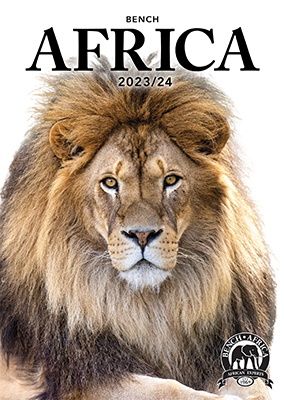






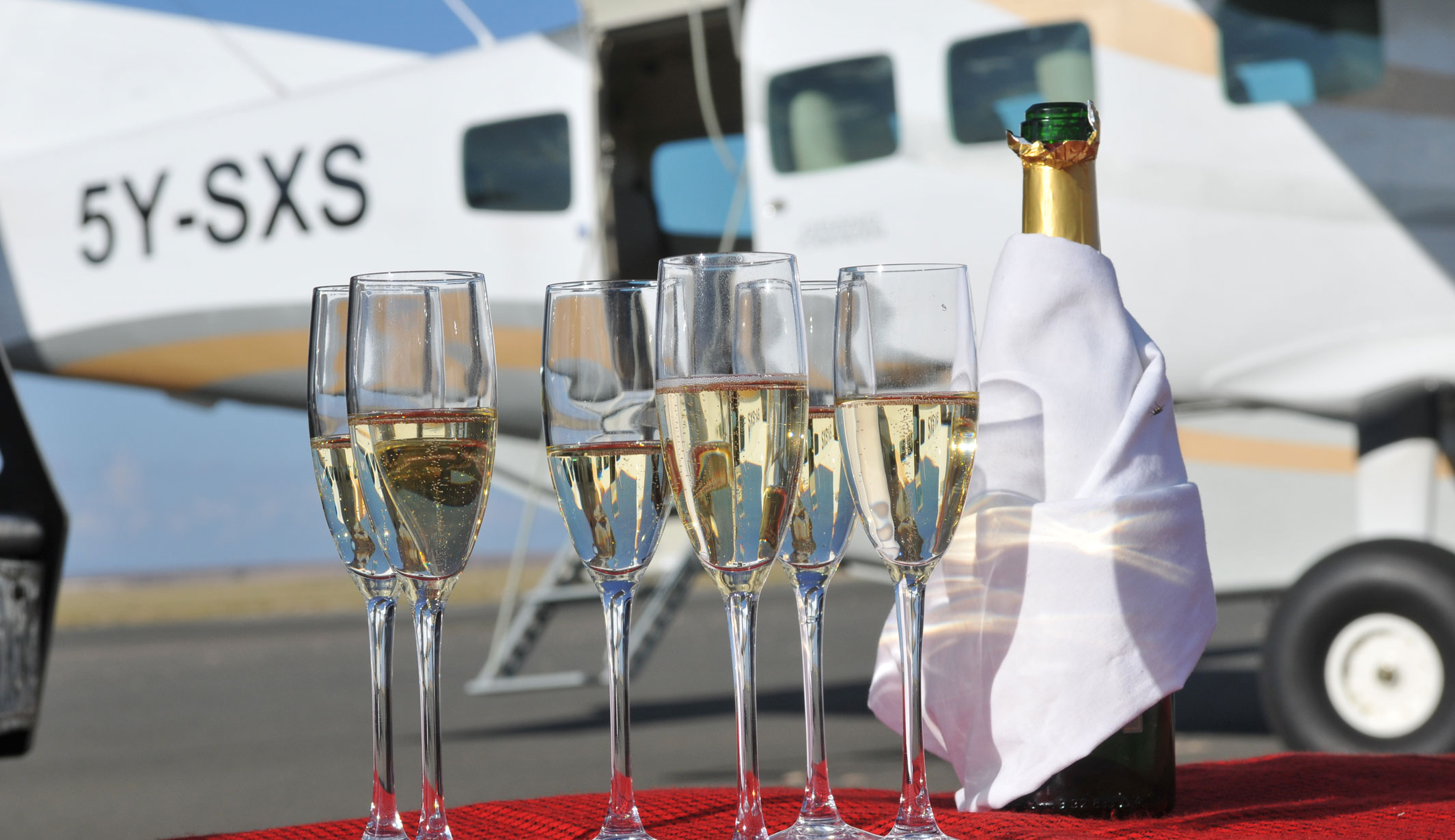



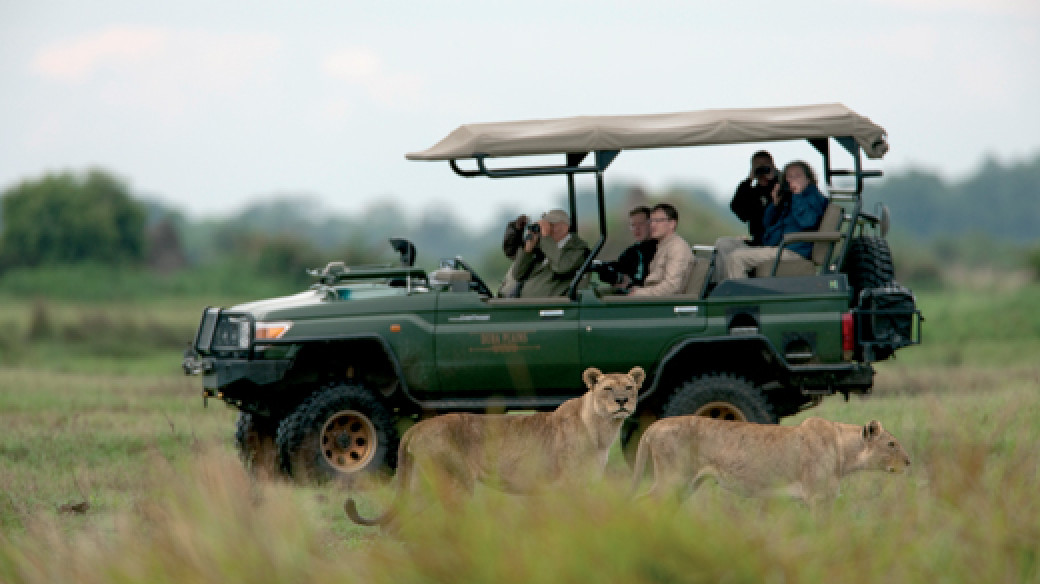
 Lodges/Camps/House boat
Lodges/Camps/House boat 


